Cue the controversy! We’re diving into the pros and cons of GMOs. There are usually a lot of spirited opinions and debates around genetically modified foods, but I intend to keep this article as neutral and impartial as possible. There’s a lot of public skepticism around the topic. Is the fear warranted? Should you be concerned about GMOs? What should you look out for?
Let’s dive into all the details. Keep reading to learn more!
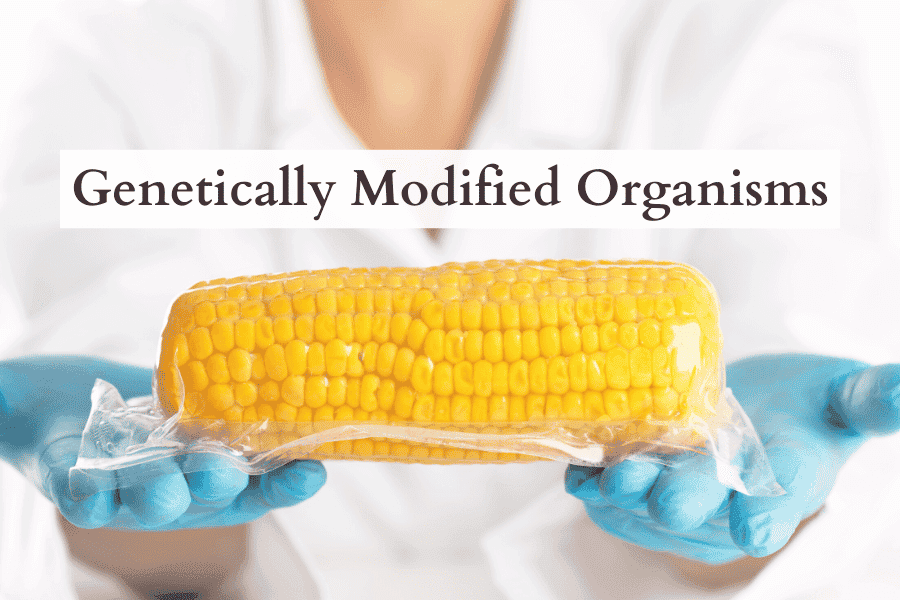
Note: This article contains affiliate links, meaning In On Around will make a small commission at no additional cost to you. This helps me maintain the site. As always, I value full transparency & only work with brands I love and trust.
What Are GMOs?
GMOs or “Genetically Modified Organisms” are living organisms that have had their genes altered in one way or another. They can be bacteria, animals, or crops, and have also been used to create medicine and textiles. Since GMOs have had their genes altered, they’re prohibited from USDA-certified organic products (as long as it’s about 95-100% pure).
Genetically modified crops are commonly used with pesticides and herbicides, like dicamba and glyphosate. You can read more about glyphosate here: Is There Glyphosate In Organic Food? Glyphosate 101
Let’s dive into it all in more detail:
Different Types of GMOs
According to the USDA, genetically engineered crops (GE crops) can be classified either as:
- Herbicide-tolerant (HT)
- Insect-resistant (Bt)
- “Stacked” – a variety combination of both HT and Bt traits
The “stacked” variety has become increasingly popular since the year 2000, especially for cotton:
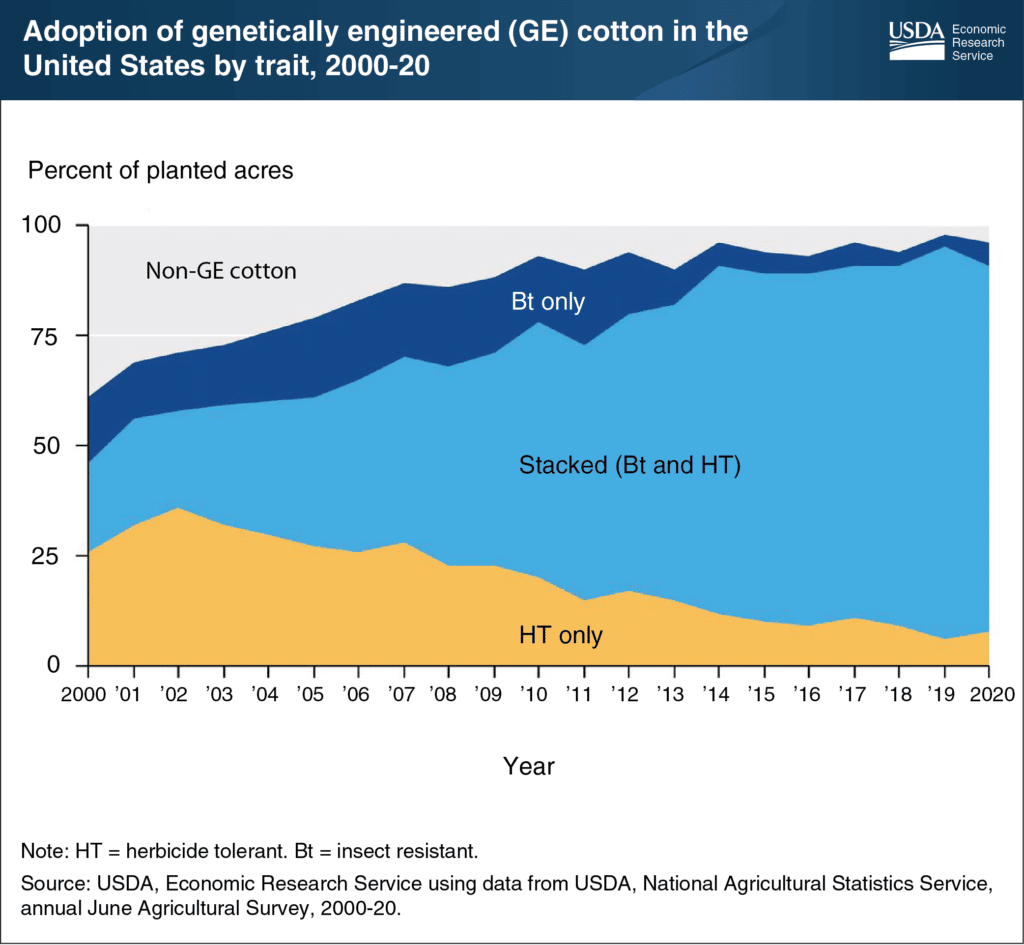
Cisgenic Vs. Transgenic GMOs
There are also distinctions between cisgenic and transgenic crops. According to ATTRA, “transgenic crops have had genetic material transferred between two unlike species. Cisgenic crops have genes that have been “edited” within that species.” [1]
Transgenic GMOs involve conventional crops like corn and soy, while cisgenic can involve CRISPR (Clustered Regularly Interspaced Short Palindromic Repeats), TALEN (Transcription activator-like effector nucleases), and RNAi (Ribo-nucleic acid interference) technology. (… yes, it’s confusing!)
Cisgenic GMOs are very, very new – they began in 2015! They also don’t have nearly the same level of regulation as transgenic crops, which can pose a significant risk.
Genetically Modified Organisms Vs. Selective Breeding
For centuries, humans have been selecting & slowly altering crops through the process called cross-breeding. This involves selecting the best of the best crops (like corn), and re-planting varieties which would increase the harvest and breed a more desirable crop. It was a natural form of “trial and error” to see what worked and what didn’t for farmers. Who wouldn’t want juicier, healthier crops?
However, today’s form of “selective breeding” is very different.
Today, laboratory scientists create transgenic genetically engineered crops as a “shortcut” approach to this selective breeding process. Instead of naturally cross-breeding, scientists:
- Identify the specific gene in the plant that is “desirable” (like resistance to bugs)
- Make copies of that specific gene within a lab
- Insert those gene copies into the cell DNA of another plant
Through this process, they have thereby modified the cells of the plant with the edited gene.
Genetically Modified vs. Genetically Engineered
There are distinct differences between genetically modified crops and genetically engineered crops. With genetic engineering, foreign DNA is introduced to a cell from an unrelated species. In genetic modification (GMOs), the crop’s current genetic material is altered or modified in some way to create a new attribute.
GMO = Genetically Modified Organism
GE = Genetically Engineered
BE = Bioengineered
While similar, they use two different modification techniques. Now, according to the USDA, “bioengineered” is food that “contains genetic material that has been modified through certain laboratory techniques and for which the modification could not be obtained through conventional breeding or found in nature.” [2]
The term bioengineered also includes cisgenic engineering techniques like CRISPR (Clustered Regularly Interspaced Short Palindromic Repeats), which is a developing genome editing tool, as mentioned above. [3]
Adoption Of GMO Crops
Every year, the adoption of genetically engineered crops increases across the United States. In 1996 adoption rates were very, very low. In fact, the first GMO food to appear on the market was a tomato in 1994. Now, most planted acres are genetically engineered. The adoption of GMO crops is fairly recent! Genetically engineered glyphosate-tolerant soybeans, for example, came on the market only in 1996.
We’re not eating the same food we used to eat.
The food our grandparents once ate is significantly different than the food we’re eating today. This is extremely important to note when we discuss the potential pros vs. cons.
The adoption of GMOs is by far the most popular in the United States (71.5 million hectares), while Brazil follows with 52.8 million hectares. [4] Most other global nations do not have nearly the same adoption of genetically modified organisms.
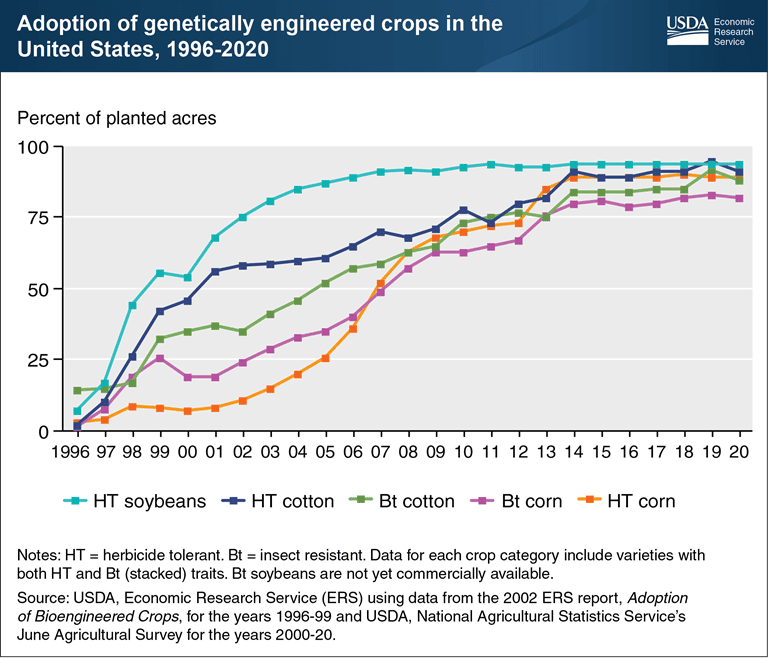
Most Common GMO Crops
The type of crops that are GMO depends on the country, however, as of September 2022, the United States allows 11 main GMO crops. According to the United States Department of Agriculture (USDA), over 90% of all corn, cotton, and soy grown in the United States is genetically modified. [5]
90%+ of corn, cotton & soy in America is GMO.
The following crops are currently allowed to be genetically modified:
- Alfalfa
- Apples
- Canola
- Corn
- Cotton (ex: cottonseed oil)
- Papaya
- Pink Pineapple – this is a new one!
- Potatoes (including reduced-browning potatoes)
- Soybeans
- Summer Squash/Zucchini
- Sugar Beets (a main source for refined sugar)
This list also includes products derived from these crops, like vegetable oils, flours, proteins, syrups, and more. For example, soy lecithin, soy isolate, and soy flour can all be derived from GMO soy.
GMO advocates & lobbyists are always pushing for this list to grow, so it’s important to keep up-to-date on the latest agricultural news!
Bioengineered/GMO tomatoes and beef, for instance, are coming down the pike. It will take about 2 years for this beef to come on the market, but this is (unfortunately) just the start of bioengineered animal products. Some cattle are now being bred to “better withstand climate change,” so they’ll have a shorter “slick” coat. Keep an eye on this as it rolls out.
GMOs In Animal Farming
GMOs are commonly used in animal agriculture. In fact, over 95% of animals used for meat and dairy in the United States eat GMO crops. YES, 95%! If a meat product does not specify that it’s non-GMO or organic, always assume that it was fed GMOs.
Cattle that will become certified organic beef cannot be fed GMO corn, grain, alfalfa, or other feed. No genetically modified feed can be used at all in organic farming (which is a win)!
Over 95% of animals used for meat and dairy in America eat GMO crops.
New GMO Labeling Requirements
As of January 2020, the genetically modified crop labeling requirements have changed. This is, frankly, an effort by the FDA & USDA to DECREASE transparency on genetically modified ingredients. Products with GMOs are now required to list them on the label as “bioengineered.”
The new bioengineered logo is also intended on making it seem more “natural,” (it has a picture of sunny green grassy fields). The terminology can be confusing to consumers (especially since most people are unfamiliar with most shoppers). This change has made it VERY difficult to know if a product contains genetically modified ingredients, especially if brands choose not to disclose it clearly. There are new loopholes in the regulation.
Some important things to note about this change:
- Processed foods that use bioengineered crops, like sodas or cooking oils, do not need to disclose if they’re under the 5% margin.
- Many prepared foods found in the freezer aisle, like meat lasagnas, might have bioengineered ingredients without disclosure.
- The milk from cows who eat bioengineered alfalfa are not required to be listed as bioengineered (the law applies for human food, not livestock feed)
- Since there will be no in-store spot checks, brands are only inspected if someone (like a consumer) complains & reports them.
- The use of the term “bioengineered” allows food manufacturing companies to use very new cisgenic methods (like CRISPR) within the food supply with little-to-no regulation. Since they’re technically “genetic deletions” instead of “genetic additions,” the USDA does not require labeling to the same degree. HUGE red flag! This is a very tricky loophole meaning gene-edited foods do not need FDA approval and labeling is voluntary. [BIG ISSUE]
- The law applies for human food, not livestock feed
It’s not required to specify on the label exactly which ingredients are GMO and which are not. Most manufacturers are not fully transparent about it and consumers are left in the dark.
Important Note: As of January 2020, GMO labeling requirements have changed!
Label Phrasing & QR Codes
There are now 5 ways that food manufacturing companies can disclose if they’re using bioengineered ingredients:
- Written directly on the package, like labeling “bioengineered food” (the most common method)
- A USDA approved symbol, such as the one in the above photo
- A digital link, like a QR code, with clear instructions such as “Scan here for more food information.”
- Important note: if a product contains a QR code or a scannable label of any kind, they’re not required to also like “bioengineered” in writing on the package.
- A text message option prompting the consumer to request information like, “Text [command word] to [number] for bioengineered food information.”
- A telephone number or URL that consumers can call or visit for more food information.
USDA Sued Over QR Codes
*Important update as of September 2022*
If companies require shoppers to go to a separate website, link, text message, or call a number to request information, then it could discourage shoppers from taking the next step towards learning about what they’re truly eating. A QR code is not enough information to properly inform a consumer about the presence of bioengineered ingredients! It’s, frankly, just putting up a curtain to make it less transparent.
A judge recently ruled that GMO labeling needs more than just a QR code. The USDA acted unlawfully. Hopefully, this will enact change and require the USDA to revise its ruling. [6, 7] The USDA was even sued prior to their 2018 ruling since a 3rd party study showed that electronic disclosures can oftentimes fail and are not adequate methods to fully disclose ingredient information. [8] These electronic disclosures can be extremely confusing to use for consumers, especially those with a lack of technical knowledge. Proper internet or phone connection is also oftentimes required to gain that information, but in-store WiFi may be limited, especially in smaller or rural retailers. This was creating a major food transparency accessibility issue!
The new bioengineered labeling laws will cause further confusion amongst shoppers.
USDA Organic Vs. Non-GMO Verified Certifications
There are distinct differences between the USDA certification and Non-GMO Verified certification. The Non-GMO Project Verified seal only takes into account whether a product contains GMO ingredients. It does not consider the use of chemical fertilizers, synthetic substances, irradiation, or sewage sludge (unlike USDA organic).
USDA Organic is far SUPERIOR to Non-GMO Verified, however, both are far superior to conventionally grown produce (or produce without full ingredient disclosure or transparency). Non-GMO verified certification can be helpful when searching for conventional GMO-grown crops.
Here is a great explanation by Boston Organics of the differences between the two certifications:
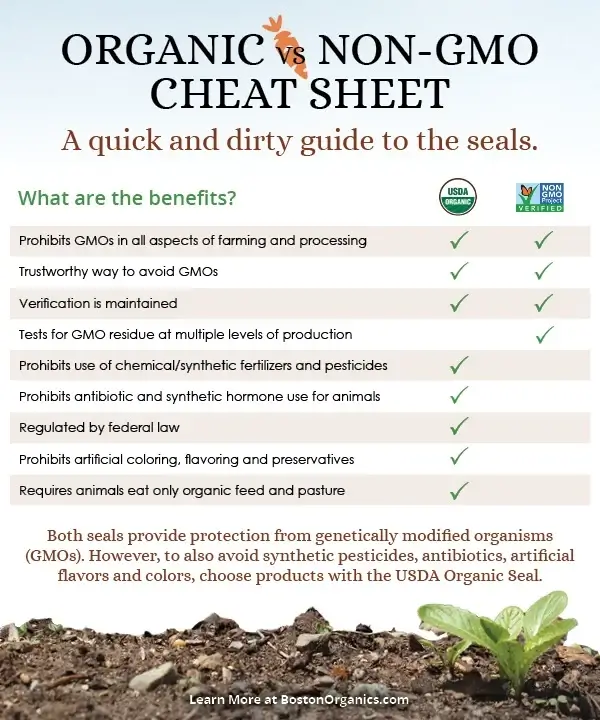
Greenwashing Alert: Some packed products will slap a “Non-GMO Verified” seal on the products after being certified, even if their products would have never contained GMOs in the first place. This is a common greenwashing tactic used in the food manufacturing space. If a product (like plain almonds) lists “non-GMO” on the label, this is a marketing ploy, since they wouldn’t be genetically modified in the first place.
Are GMOs In Organic Food?
No, USDA organic certification prohibits the use of bioengineered ingredients or genetically modified ingredients. The USDA requires that certified organic products are 95-100% organic ingredients only, so, at most, a product would contain about 5% GMO ingredients.
Even if a product has the “100% USDA Organic Certified” seal, it can contain up to 5% of GMO ingredients (mostly because cross-contamination is almost impossible to avoid). The USDA organic prohibits the use of chemical fertilizers, irradiation, synthetic substances, sewage sludge, and GMOs.
In the European Union (EU), foods with over 0.9% GMO ingredients must list either “genetically modified” or “produced from genetically modified [name of food.]”
Important distinction: Organic certified is always non-GMO, but non-GMO is not necessarily always organic.
Pros of GMO Foods
Let’s dive into the arguments in favor of bioengineered foods. Note: be sure to read the cons, since some of these arguments are debunked!
1 – Crop Yield
- Potential for improved crop yield – when certain crops are left untreated they can be overcome by weed infestations which can significantly reduce the crop yield, sometimes up to 50%. [8]
- They’re more weather resistant and insect/pest resistant (easier for farmers to grow), leaving them less bruised or damaged.
2 – Fewer Pesticides
- Some argue that GMO crops use fewer pesticides since they’re less vulnerable to insects
- However, a 2020 study found that GMO crops reduced pesticide use only by about 8.3% initially, while conventional non-organic crops allow for more harmful pesticide ingredients. [9] Over time, superbugs become resistant to the gene-edited crops & can force farmers to use pesticides once again.
3 – Affordability
- Since GMO crops are more popular and in more supply, they’re usually more affordable (supply + demand in action).
4 – Shelf Life
- They can have a longer shelf life (usually because of herbicide use)
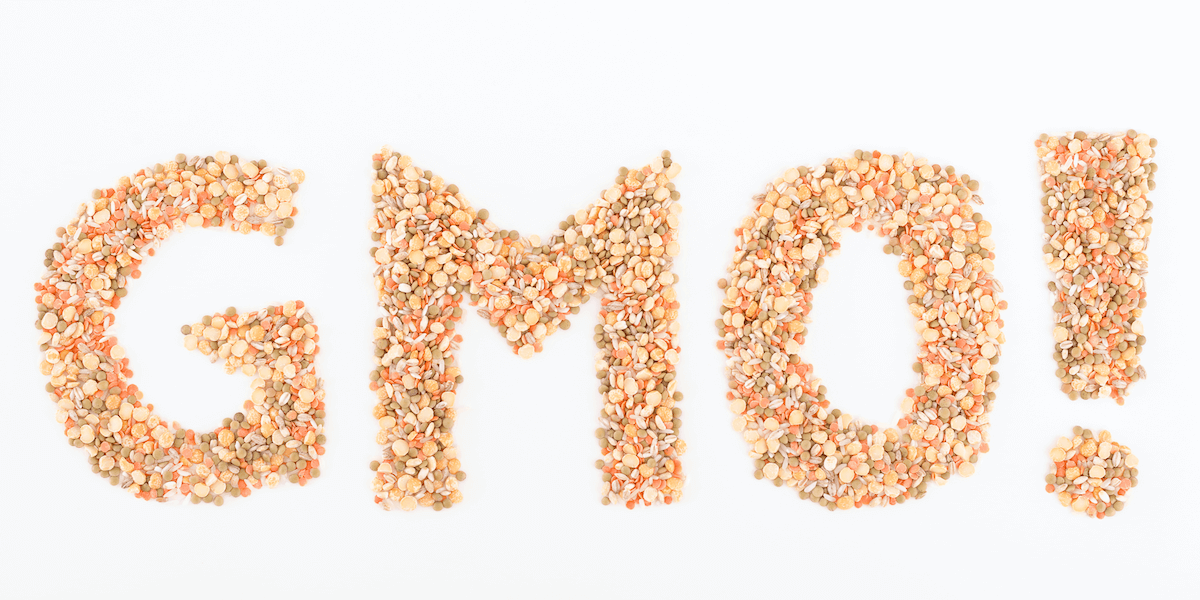
Cons of GMO Foods
Now let’s dive into the many potential cons of GMO foods:
1 – Health & Environmental Impacts
- Long-term health & environmental impacts are unknown. This is a new agricultural practice!
- They may negatively impact insects and other species. The full environmental risk to bees and other pollinators is unknown, yet their population is on a sharp and concerning decline.
2 – Failed Crop Yields
- The “improve crop yield” argument is debated since some GM crop yields fail. Some studies have even shown a decrease in crop yield! [10, 11, 12, 13]
3 – Antibiotic Resistance
- May increase antibiotic resistance, which is a major issue! May even be passed through feces into sewage systems, which creates an even larger issue. [14]
- GM crops are losing their effectiveness and superbugs are taking over. Monsanto even admitted that Bt cotton failed since the pink bollworm developed resistance. [15]
4 – Soil Degradation
- GM crops may contribute to soil degradation, putting the future of food security at risk and polluting our landscapes. [16, 17]
5 – Corporate Greed
- GMO seeds are manufactured by a select few large companies that own the intellectual property for the variations (big $$$ for these profiteering companies!). They are able to control the use and distribution of these seeds.
- The same companies who are creating the seeds (like Monsanto) are creating the pesticides/herbicides tolerant to those seeds (ex: Glyphosate-tolerant crops). There’s a ton of corporate control and heavy industry & political influence in the push for GMOs.
- Small-scale farmers are even at risk of being sued by these mega corporations if their crops are contaminated (likely through wind) with a patented GMO crop that they don’t legally purchase. It’s all centered around profits, not people.
- There’s also a potential for bias with data surrounding GMO products. Can we really trust the “science” when the companies creating the product are leading the research?
6 – Cancers
- Since many GMO crops are specific herbicide-tolerant, the crops are sprayed with potentially toxic chemicals. You can read more about that here.
- We cannot fully confirm if GMOs cause cancer or not since it’s so new. “Insufficient evidence” doesn’t mean that it’s not necessarily true – it means we don’t have the long-term data to confirm or deny it yet.
7 – Allergies
- There’s concern that GMOs may be linked to allergic reactions in some individuals. Since genetically engineered foods are very unstable, they can introduce and elevate levels of certain allergens, especially as they cross-pollinate.
8 – Outcrossing
- There’s a risk of outcrossing, meaning GMO crops can breed with wild crops, creating new hybrids that weren’t intended to be created.
- Once GMOs are released into the environment, they can never be recalled. It’s a permanent chance in the agricultural landscape that threatens crop diversity. We’re forever altering nature and threatening native species.
8 – Morality Concerns
- Since GMOs contain altered DNA, are we “playing God?” There are ethical and moral considerations to keep in mind! We’re playing with nature.
9 – Biodiversity
- Intensive mono-crop farming where the same strains of GMO corn and soy are grown in mass, can reduce flavor profiles and decrease crop diversity. Monocrop farming or “simple crop rotation” can deplete the soil of nutrients and make it less productive over time. It can even lead to erosion and poor microbial growth in soil.
Can We Feed The World Without GMOs?
Controversial topic alert: GMOs do not feed the world. The issues around food poverty do not lie in food production. We are farming and producing enough food! The issue lies in food distribution and food waste management.
The majority of GMO crops go towards animal feed (mostly factory-farmed), textiles, and biofuels, like the production of ethanol. It’s not always for direct food consumption! We don’t need GMOs to feed the world – even with a rapidly growing population.
Hunger comes from socioeconomic inequity – it does not come from food shortage.
The United States wastes about 30-40% of its food. [18]
What To Do About GMOs
- When possible, avoid products with a bioengineered label. Read ingredient labels very carefully – especially look for ingredients that could be derived from GMO crops (think: lecithin, flours, oils, etc…)
- Opt for 100% certified organic products (organic is non-GMO, but non-GMO is not necessarily organic).
- Support local, regenerative, organic farms that raise animals the way nature intended
- If you can’t find an organic variety of a crop, opt for the non-GMO version.
- If you see a brand clearly breaking the bioengineered law (not properly disclosing it), file a report.
- Encourage homesteading/growing food at home or starting an organic vegetable garden
- Instead of potentially toxic herbicides, opt for safer options like Sunday Lawn Care
- When you spot a non-GMO label, check to see if any of the ingredients would even be grown genetically modified at all (this is a big marketing greenwashing ploy)
- When shopping for meat, look for the following:
- Organic
- Pasture-raised (regeneratively farmed & humanely raised)
- Grass-fed & grass-finished (meaning the animal was fed grass up until slaughter)
- Local (whenever possible)
- Preservative-free (as long as it’s fresh) – nitrite & celery extract/celery powder free
- You can learn more about processed meat here: What Is The Healthiest Lunch Meat? Processed Meat 101
Final Thoughts – The Bottom Line On GMOs
Whether you’re pro-GMO or anti (it’s a heated topic)… we all deserve to know what’s in our food & make informed choices. Keep your eyes peeled for this change in the food industry.
Genetic modification comes with serious consequences.
After analyzing the pros and cons of genetically engineered crops from a neutral perspective, the answer is clear: the cons far outweigh the pros. Avoiding GMOs whenever possible is the best course of action. Whether you plan to buy GMO products or not, it’s clear that the changing regulations and labeling laws are weak. We all deserve to know what’s in our food, so let’s keep fighting for more food transparency!
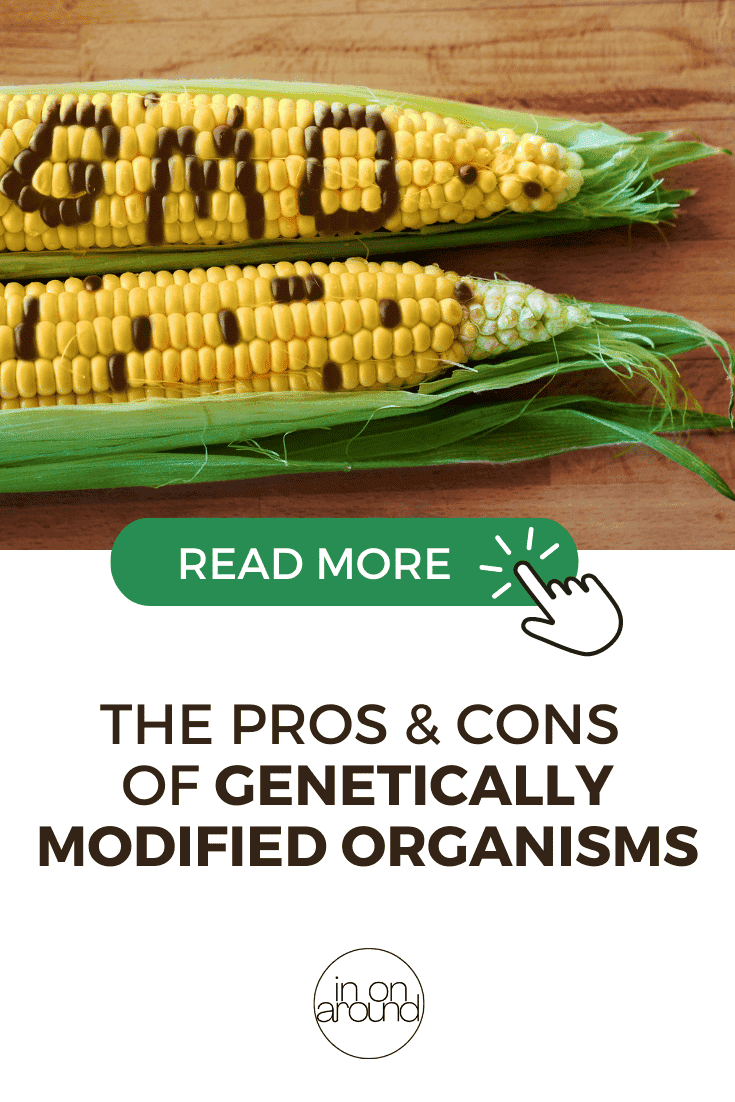
Pros And Cons of GMOs – Frequently Asked Questions
Click on the below FAQs to learn more about the pros and cons of GMOs!
What’s the difference between genetically modified vs. genetically engineered?

There are distinct differences between genetically modified crops and genetically engineered crops. With genetic engineering, foreign DNA is introduced to a cell from an unrelated species. In genetic modification (GMOs), the crop’s current genetic material is altered or modified in some way to create a new attribute.
How recent was the adoption of GMOs?
What are the most popular GMO crops?
Can we feed the world without GMOs?
What are your thoughts on GMOs?
Let me know your thoughts in the comments below!
You can watch our web story here.
xoxo,

Want to read more? Check out my other articles here!
References on Pros and Cons of GMOs – Information from: FDA, USDA, Economic Research Service, Cornucopia Institute, Anti A, Boston Organics (photo), Non-GMO Project, Insider, WSU, Medical News Today, Living Non-GMO, Auburn, Morgan Myers, Washington Post, PEDIAA, Scantrust, Alliance For Science, Dr. Axe, Sustainable Agriculture, Center For Food Safety, ZBiotics, Green America, Seed World, National Geographic, Slow Food, Iowa State, Eden Foods, Foodprint
Copyright In On Around LLC 2022 ©. The statements made on this website have not been evaluated by the FDA (U.S. Food & Drug Administration). They are not intended to diagnose, treat, cure, or prevent any disease. The information provided by this website should not be used as individual medical advice and you should always consult your doctor for individual recommendations and treatment. The information contained in this site is provided on an “as is” basis. Related to this site, there are no guarantees of completeness, accuracy, usefulness, or timeliness. In On Around LLC assumes no responsibility or liability for any errors or omissions in the content of this site.


